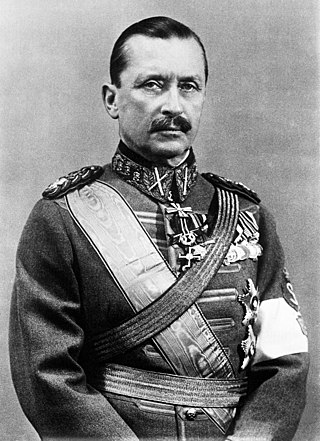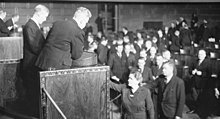
Urho Kaleva Kekkonen, often referred to by his initials UKK, was a Finnish politician who served as the eighth and longest-serving president of Finland from 1956 to 1982. He also served as prime minister, and held various other cabinet positions. He was the third and most recent president from the Agrarian League/Centre Party. Head of state for nearly 26 years, he dominated Finnish politics for 31 years overall. Holding a large amount of power, he won his later elections with little opposition and has often been classified as an autocrat. Nevertheless, he remains a respected figure.

Kyösti Kallio was a Finnish politician who served as the fourth president of Finland from 1937 to 1940. His presidency included leading the country through the Winter War; while he relinquished the post of commander-in-chief to Carl Gustaf Emil Mannerheim, he played a role as a spiritual leader. After the war, he became both the first President of Finland to resign and the only one to die in office, dying of a heart attack while returning home after submitting his resignation.

Baron Carl Gustaf Emil Mannerheim was a Finnish military leader and statesman. He served as the military leader of the Whites in the Finnish Civil War (1918), as Regent of Finland (1918–1919), as commander-in-chief of the Finnish Defence Forces during the period of World War II (1939–1945), and as the sixth president of Finland (1944–1946). He became Finland's only field marshal in 1933 and was appointed honorary Marshal of Finland in 1942.

Juho Kusti Paasikivi was a Finnish politician who served as the seventh president of Finland from 1946 to 1956. Representing the Finnish Party until its dissolution in 1918 and then the National Coalition Party, he previously served as senator, member of parliament, envoy to Stockholm (1936–1939) and Moscow (1940–1941), and Prime Minister of Finland. He also held several other positions of trust, and was an influential figure in Finnish economics and politics for over fifty years.

Lauri Kristian Relander was the second president of Finland (1925–1931). A prominent member of the Agrarian League, he served as a member of Parliament, and as Speaker, before his election as President.

Risto Heikki Ryti was a Finnish politician who served as the fifth president of Finland from 1940 to 1944. Ryti started his career as a politician in the field of economics and as a political background figure during the interwar period. He made a wide range of international contacts in the world of banking and within the framework of the League of Nations. Ryti served as prime minister during the Winter War and the Interim Peace, and as president during the Continuation War.

Kaarlo Juho Ståhlberg was a Finnish jurist and academic who was one of the most important pioneers of republicanism in the country. He was the first president of Finland (1919–1925) and a liberal nationalist.

The president of the Republic of Finland is the head of state of Finland. The incumbent president is Sauli Niinistö. He was elected for the first time in 2012 and was re-elected in 2018. The next president of Finland will be elected in 2024.

Väinö Alfred Tanner was a leading figure in the Social Democratic Party of Finland, and a pioneer and leader of the cooperative movement in Finland. He was Prime Minister of Finland in 1926–1927.
The National Coalition Party is a liberal-conservative political party in Finland.

The war-responsibility trials in Finland were trials of the Finnish wartime leaders held responsible for "definitely influencing Finland in getting into a war with the Soviet Union and United Kingdom in 1941 or preventing peace" during the Continuation War, the Finnish term for their participation in the Second World War from 1941–1944. Unlike other World War II war-responsibility trials, the Finnish trials were not international. The trials were conducted from November 1945 through February 1946 by a special court consisting of the presidents of the Supreme Court of Finland, the Supreme Administrative Court of Finland, a professor from the University of Helsinki and twelve MPs appointed by the Parliament of Finland. The accused were convicted and were imprisoned until they were eventually paroled and then pardoned.

Tamminiemi is a villa and house museum located in the Meilahti district of Helsinki, Finland. It was one of the three official residences of the President of Finland, from 1940 to 1982. From 1956, until his death, it served as the residence of President Urho Kekkonen. Since 1987, it has been the Urho Kekkonen Museum. Tamminiemi is located in a park by the sea. Its floor area is about 450 square metres (4,800 sq ft); living quarters comprise the first two floors while the third floor is dedicated to office space.

Parliamentary elections were held in Finland on 17 and 18 March 1945. The broad-based centre-left government of Prime Minister Juho Kusti Paasikivi remained in office after the elections.

Presidential elections were held in Finland on 16 January 1994, with a second round on 6 February. It was the first time the President had been solely and directly elected by a popular vote. Martti Ahtisaari defeated Elisabeth Rehn in the second round.
Two-stage presidential elections were held in Finland in 1925. On 15 and 16 January the public elected presidential electors to an electoral college. They in turn elected the president. The result was a victory for Lauri Kristian Relander, who won on the third ballot. The turnout for the popular vote was just 39.7%. The outgoing president, K.J. Ståhlberg, had refused to seek a second term. According to the late Agrarian and Centrist politician, Johannes Virolainen, he stepped down after one term because he believed that an incumbent president would be too likely to win re-election. President Ståhlberg claimed that he had already completed his political service to Finland as president. Moreover, he wanted to step down because many right-wing Finns opposed him. According to Pentti Virrankoski, a Finnish historian, President Ståhlberg hoped that his retirement would advance parliamentary politics in Finland. Ståhlberg's party, the Progressives, chose Risto Ryti, the governor of the Bank of Finland, as their presidential candidate. The Agrarians only chose Lauri Kristian Relander as their presidential candidate in early February 1925. The National Coalitioners originally chose former Regent and Prime Minister Pehr Evind Svinhufvud as their presidential candidate, but before the presidential electors met, they replaced Svinhufvud with Hugo Suolahti, an academician working as the rector (principal) of the University of Helsinki. Relander surprised many politicians by defeating Ryti as a dark-horse presidential candidate, although he had served as the Speaker of the Finnish Parliament, and as Governor of the Province of Viipuri. Ståhlberg had quietly favoured Ryti as his successor, because he considered Ryti a principled and unselfish politician. He was disappointed with Relander's victory, and told one of his daughters that if he had known beforehand that Relander would be elected as his successor, he would have considered seeking a second term.
Two-stage presidential elections were held in Finland in 1950, the first time the public had been involved in a presidential election since 1937 as three non-popular elections had taken place in 1940, 1943 and 1946. On 16 and 17 January the public elected presidential electors to an electoral college. They in turn elected the President. The result was a victory for Juho Kusti Paasikivi, who won on the first ballot. The turnout for the popular vote was 63.8%. President Paasikivi was at first reluctant to seek re-election, at least in regular presidential elections. He considered asking the Finnish Parliament to re-elect him through another emergency law. Former President Ståhlberg, who acted as his informal advisor, persuaded him to seek re-election through normal means when he bluntly told Paasikivi: "If the Finnish people would not bother to elect a President every six years, they truly would not deserve an independent and democratic republic." Paasikivi conducted a passive, "front-porch" style campaign, making few speeches. By contrast, the Agrarian presidential candidate, Urho Kekkonen, spoke in about 130 election meetings. The Communists claimed that Paasikivi had made mistakes in his foreign policy and had not truly pursued a peaceful and friendly foreign policy towards the Soviet Union. The Agrarians criticized Paasikivi more subtly and indirectly, referring to his advanced age, and speaking anecdotally about aged masters of farmhouses, who had not realized in time that they should have surrendered their houses' leadership to their sons. Kekkonen claimed that the incumbent Social Democratic minority government of Prime Minister K.A. Fagerholm had neglected the Finnish farmers and the unemployed. Kekkonen also championed a non-partisan democracy that would be neither a social democracy nor a people's democracy. The Communists hoped that their presidential candidate, former Prime Minister Mauno Pekkala, would draw votes away from the Social Democrats, because Pekkala was a former Social Democrat. The Agrarians lost over four per cent of their share of the vote compared to the 1948 parliamentary elections. This loss ensured Paasikivi's re-election. Otherwise Kekkonen could have been narrowly elected President - provided that all the Communist and People's Democratic presidential electors would also have voted for him.

Early and indirect presidential elections were held in Finland in 1940 after President Kyösti Kallio resigned on 27 November following a stroke on 27 August. The 1937 electoral college was recalled and elected Prime Minister Risto Ryti, who received 288 of the 300 votes. Most other Finnish politicians considered Ryti a principled, unselfish, intelligent and patriotic man, who could lead Finland effectively enough during World War II. His leadership qualities had been tested already during the Winter War. Also the outgoing President Kallio considered him the best available presidential candidate. In early December 1940, the Soviet Foreign Minister, Vyacheslav Molotov, interfered with the Finnish presidential elections by claiming to the Finnish Ambassador to the Soviet Union, Juho Kusti Paasikivi, that if potential presidential candidates such as Marshal Carl Gustaf Emil Mannerheim, former President Pehr Evind Svinhufvud, or former Prime Minister Toivo Mikael Kivimäki were elected President, the Soviet government would consider Finland unwilling to fulfill its peace treaty with the Soviet Union. Due to the lingering threat of another war and the Karelian refugees' dispersal throughout Finland, regular presidential elections were cancelled, and instead the 1937 presidential electors were summoned to elect the President. Under these tense political circumstances, Ryti had no problem winning these exceptional presidential elections by a landslide. The same day, former president Kallio died.

Two-stage presidential elections were held in Finland in 1956. On 16 and 17 January the public elected presidential electors to an electoral college. They in turn elected the President.

Georg Carl Casimir Ehrnrooth was a Finnish politician and lawyer. He was a member of the Parliament for Helsinki from 1958 to 1979 and again from 1983 to 1987. He initially represented the Swedish People's Party of Finland but in 1973 he left the party and formed a new political party called the Constitutional People's Party, later known as the Constitutional Right Party. He served as its leader from 1974 to 1992.

Kaarlo Henrik Hillilä was a Finnish politician who served as the provincial governor of Lapland (1938–1947), head of the market town of Rovaniemi, minister of the interior (1944–1945), minister of supply (1945–1946), and director general of the Social Insurance Institution (1946–1954).




















